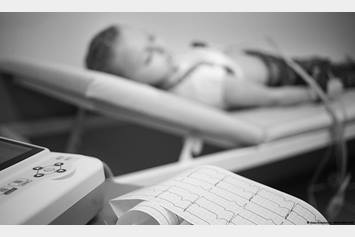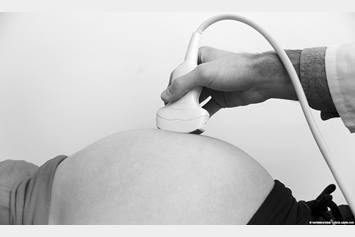Atrial Septal Defect
Atrial Septal Defects (ASD) are congenital heart defects characterized by a hole in the wall between the atria. Symptoms include shortness of breath, fatigue, heart palpitations, and swelling.
What Are Atrial Septal Defects?
The normal human heart is responsible for efficiently receiving and pumping blood. Proper blood flow is vital to health because the body's tissues rely on the blood to carry nourishment (oxygen, glucose) and remove waste products (carbon dioxide). Under normal conditions, the cardiovascular system (heart, blood vessels) contains two separate circulatory systems - venous (right) and arterial (left). Venous (deoxygenated, blue) blood returns from the body to the right atrium.
Blood flows from the right atrium through the tricuspid valve into the right ventricle where blood is actively pumped across the pulmonary valve and into the pulmonary arteries. The main pulmonary artery divides into large right and left pulmonary arteries and then to small pulmonary arterioles. Adjacent to the small arterioles, numerous pulmonary air filled sacs. Within these small sacs, gases are exchanged. Waste products from the venous blood enter the air sacs and are removed from the pulmonary system when we breathe out (exhale). Oxygen that enters the lungs when we breathe in (inspiration) enters the small air sacs and diffuses into the blood. Oxygen-rich (red) blood returns from the lungs via pulmonary veins to the left atrium.
Muscular and connective tissues separate the right (blue blood) from the left (red blood) side of the heart. The heart is separated at the level of the receiving chambers (right and left atria) by the atrial septum, and at the pumping chambers (right and left ventricles) by the ventricular septum. Persistent opening between the atrial and ventricular septa in postnatal life is abnormal.
What Are the Different Types of ASD?
There are three common types of atrial septal defect (ASD):
- Ostium Secundum - located in the center of the atrial septum (most common type)
- Ostium Primum - located near the lower portion of the atrial septum, may be associated with defects in the mitral and tricuspid valve (second most common type)
- Sinus Venosus - located near the top of the atrial septum and frequently associated with abnormal connection of the right pulmonary vein(s) to the right atrium instead to the left atrium (least common type)
Passive blood flow through the heart is driven by pressure differences. Blood flows across heart valves or other orifices from one chamber from high to low pressure. In atrial septal defect, there is usually higher pressure in the left atrium compared to right atrium, thus blood flows (or shunts) from left to right. Medical/surgical recommendations for closure of the ASD depend primarily on characteristics of the defect itself (size, location), symptoms or limitations related to the defect, and preferences of the patient and physician.
How Is ASD Diagnosed?
Symptoms and/or abnormal examination findings such as abnormal splitting of the second heart sound, murmur, abnormal cardiac impulse raise concern for ASD. Common symptoms include irregular or rapid heart rhythm, cyanosis (bluish nails and skin), shortness of breath with or without exertion, cough, dizziness, fainting, fatigue, swelling (hands, face or legs), lack of appetite. Adults with ASD are frequently asymptomatic with minimal physical manifestations of ASD, and ASD may go undetected for many years.
History and physical examination findings that raise suspicion of ASD are followed by one or more diagnostic/imaging tests. These include: echocardiography-transthoracic, transesophageal (TEE) and intracardiac echocardiography; angiography (cardiac catheterization); and magnetic resonance imaging (MRI).
How Is ASD Treated?
Medical Therapy
Diuretics and antiarrhythmia medications may be needed to treat the symptoms of ASD, however definitive therapy requires closure of the ASD.
ASD Closure
There are two approaches to ASD closure:
- Open heart surgery. Surgery is required for patients with ostium primum and sinus venous ASD and is recommended in early childhood. Smaller defects are closed with sutures, whereas large defects require patches made of synthetic material or pericardium (the lining of the heart).
- Catheter-based closure. Patients with secundum ASD may opt for catheter-based ASD closure. Via femoral artery and/or vein access, the septal occluder is passed into the atrial septal region. Varying sizes of septal occluder devices are available. Appropriately sized devices are chosen according to the size of the ASD. The occluder device is constructed of flexible wire containing nickel and titanium (nitinol). Two nitinol discs are connected by a middle waist-one of the discs is placed on the left atrial side of the ASD; the waist sits in the region of the ASD, and the other disc is placed on the right atrial side of the ASD. The device is retractable in the introducing apparatus and can be deployed or retracted as necessary until proper placement is achieved. Echocardiography can detect persistent interatrial shunting and is usually performed during and post catheter-ASD closure to assess catheter device closure success. From the time of ASD device implantation until approximately six months following implantation, connective tissues adhere to the device. During this time it is necessary to minimize the occurrence of platelet adhesion, therefore clopidogrel (Plavix) and aspirin are given for three and six months respectively following ASD catheter-device closure.
What Are the Long-term Consequences of ASD?
Potential long-term consequences of atrial defects include:
- Increased blood flow to the right side of the heart (left to right shunting)
- Volume overloading in the right sided heart chambers (left to right shunting)
- Right ventricular weakening
- Swelling in the veins of the neck, liver and extremities
- Increased blood flow to the lungs (pulmonary overcirculation)
- Pulmonary congestion
- Increased chest infections
- Development of high pressures in the blood vessels in the lungs (pulmonary hypertension)
- Blood clots that travel in the circulation are called emboli. Emboli can cross the atrial septal defect, enter the arterial circulation, and become lodged in a small artery of the brain, heart, kidneys, arms, legs, etc, and can result in stroke, heart attack or damage to other organs.
- Irregularities in heart rhythm caused by stretched right atrium/ventricle
- Sudden unexpected cardiac death, usually due to arrhythmia
In order to minimize the detrimental long-term complications related to ASD (volume and pressure overload, serious arrhythmias) and to prevent embolic events, ASD closure is usually recommended for children and adults.
What Research Has Been Done Related to ASD?
ASD is two to three times more common in girls than boys. ASD may alone or as an associated congenital cardiac defect. Atrioventricular conduction defects, ventricular septal defect, tetralogy of Fallot, and a variety of complex cyanotic congenital heart disease defects have occurred with ASD. A family history/pedigree showing relatives from different generations with ASD raises strong suspicion of a genetic etiology. ASD is heterogeneous (caused by more than one gene). ASD occurs in individuals with a variety of syndromic and genetic disorders including Down syndrome (trisomy 21) and the following Mendelian genetic mutations:
- 4p16 (EVC; Ellis van Creveld syndrome)
- 5q34 (NKX2E)
- 6q21.3 (ASD I, ASD II)
- 8q23.1-p22 (GATA4)
- 12q24.1 (TBX5; Holt Oram syndrome)
- 20p12 (JAG1, AGS, AHD; Alagille syndrome)
- 22q11.2 (velocardiofacial/DiGeorge syndrome)



